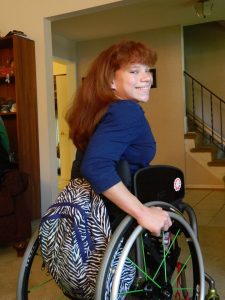contributed by Jessica Rogers

In spite of the fact that I have only half of my spine, paralysis from the waist down, no hip movement, very little torso control, and had legs bent into what is often called a “Buddha sitting position”, I actually used to “walk” in two different ways. First of all, like many children with SA/CRS who are similar to me physically, I walked on my hands. I could scamper around just about anywhere, and faster than most people on two feet. I was up and down stairs, racing around the playground, and climbing up the jungle gym, all on my arms. I even put roller skates on my hand and sailed down our steep driveway! Physically, no one really predicted walking on two feet was in my future, but that didn’t appear to hamper my mobility at all. When I was 18 months old, I received my first tiny wheelchair and used that mostly for outings or long hallways at pre-school, but when recess came, I took off across the playground, running on my hands.
I am probably the last person anyone expected to walk, but to address my seating, when I was three I had at-knee disarticulation, removing the lower part of my legs in order to allow my upper legs to come together in a forward position instead of splaying out at right angles. Even though I was only three, I had already met some adults who had this surgery, and some who had not, and I was eager to go forward. Of course, at the age of three I didn’t really understand the whole concept of surgery, so it’s a good thing this surgery is quite minor. Within a day, I was running around and enjoying moving about without my lower legs and feet getting stuck on things.
I was a gutsy kid, with great balance, and so once the position of my legs was resolved, prosthetic legs were suggested. These days, with a whole lot of time, effort, ingenuity, technology, and determination-almost anyone can be stood up and moved forward. I was a bit curious to see what it felt like to walk like my peers did, so at age 5 I was fitted with prosthetics. It took almost a year of appointments to find the right fit and design of prosthetic legs, which included a torso brace to hold me upright. The brace locked my hips in a straight position to keep me standing, and attached to the prosthetics which fit around my thighs. The knee of the prosthetics locked my legs in a straight position. At first, I used a walker, picking myself up with my arms and placing my feet forward. I moved quickly to forearm crutches and I could get myself around fairly well. I walked a little bit, maybe a couple of hours a week, from the time I was about 7 to the time I was about 9. I walked basically using all shoulder power, lifting myself up, swinging my crutches forward, picking myself up and “landing” my feet forward. This might have been “walking” by standards of society, but it was in no way independent mobility.
If I fell, I really couldn’t get back up by myself, because the prosthetics were attached to a torso brace and the hips were locked straight. If they weren’t locked, I couldn’t hold myself up, but if I fell, I was basically a wooden log on the ground until someone came and set me upright again. I could not bend over-so if I dropped something, I had to depend on someone else to get it for me. I could not get up or down stairs, so the braces and crutches didn’t give me any more mobility than a wheelchair- much less, in fact, In a wheelchair, I could reach to the ground to pick up what I dropped. I could get in and out of it without help. I could go pretty much anywhere. Walking in prosthetics, by contrast was very slow and tiring. The leg braces weighed as much as I did. You can imagine that was not very practical, but I would say I was more proficient at walking than anyone would have predicted.
By age 9, the prosthetics and walking ceased to hold any interest for me and I stuck with the wheelchair, where I added skills such as wheelies, bumping down curbs, and taking steep inclines. I continued to have the mobility option of running around on my hands whenever that was more efficient.
I’m not unhappy that I tried walking, and I’m also perfectly happy that I don’t walk now. The “cost” of this goal for walking was not particularly high because it required only one minor surgery, which I would have wanted to have anyway for other reasons. The appointments for fitting of prosthetics, and remaking them when I outgrew them did get in the way of school and other things I wanted to do. That was also a bigger “cost” calculated into the decision to try walking. The outcome allowed me to experience “walking” and then make my own decision about whether it was worthwhile for me to continue. In the end, walking held no real advantage for me. I don’t miss walking on two feet at all. I am far happier ‘walking” on my hands or using a wheelchair. Both are much faster and freer and practical for me. I don’t really perceive myself as having any limitations just because I use a wheelchair. I’ve traveled the world, climbed to the top of a waterfall (twice) and I push myself around my college campus everyday, rain, sun, or snow. I drive, swim, do my laundry, cook meals, and occasionally get around to housecleaning. I have a basketball wheelchair, a handcycle and a racing wheelchair. I love the freedom that my wheels give me.
The most important thing of all throughout this process was that my mom really listened to my feedback and followed my lead. She encouraged me and gave me options, but she never forced me or gave me the impression that walking on two feet was somehow a better way of getting around, and I appreciate that. She didn’t leave me the burden of making a complicated decision either. She did her homework and knew the best time for this kind of surgery would be when I was still young enough to easily adjust. She was realistic about the outcome long term and knew that even if we tried walking, I probably wouldn’t find it very practical, but she still supported my desire to try. Walking on two feet wasn’t a better way for me. There are kids and adults with SA/CRS who do walk, many of them walking very functionally, and of course when that option is a realistic one, and when the cost does not involve a lifetime in the hospital with surgery after surgery, it’s a wonderful option. However, it’s also important to know that there are quite a few who have a set of old prosthetics or braces and crutches or a walker in a closet somewhere, like me. They have made a decision that the wheelchair is a better option for them. It’s too bad that most of society has such a negative stigma about using wheelchairs because sometimes people are made to feel that choosing a wheelchair makes them less valid. For me, wheelchairs are liberating and give me far more independence than I could ever have by trying to walk. Pushing a wheelchair keeps me in good shape and it gets me where I want to go in a way that leaves me with enough energy to do what I need to do when I get there. The emphasis that society puts on walking on two feet seems overrated.
